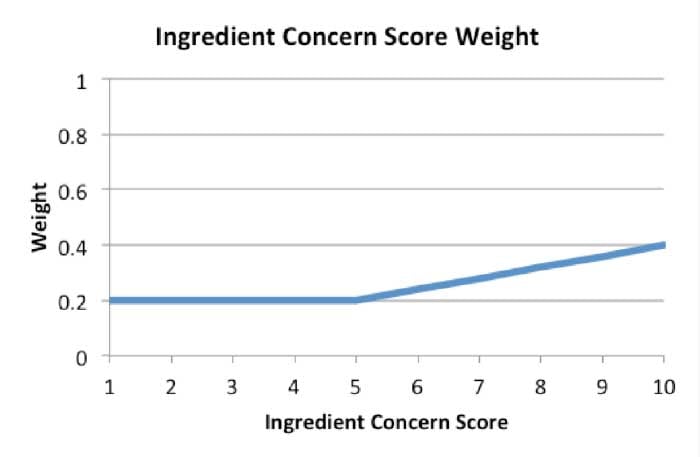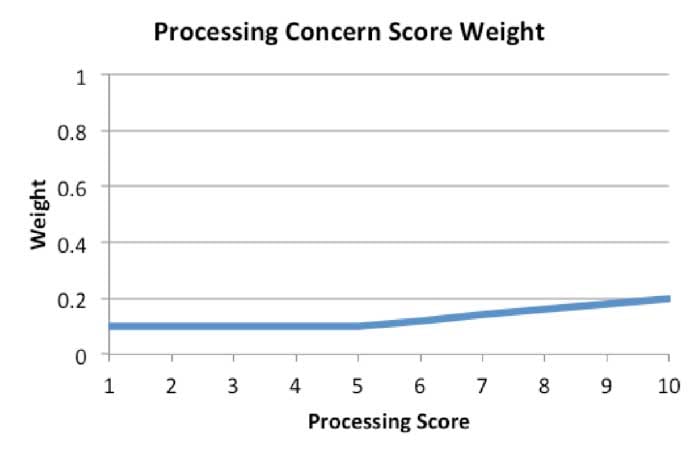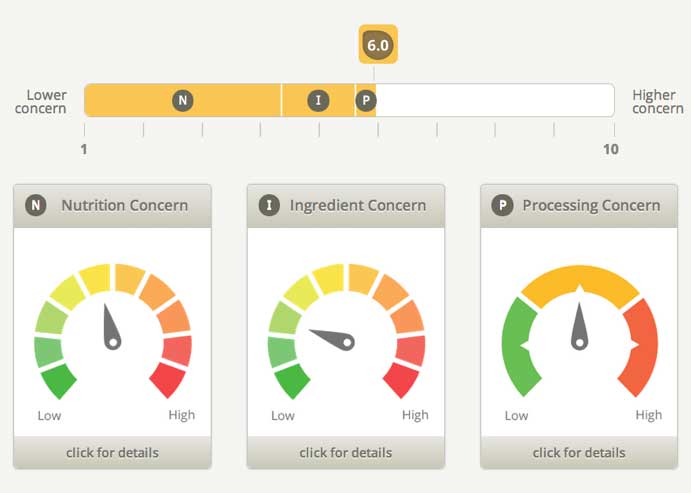These overall scores represent our integrated assessment of the food. Scores range from 1 (best) to 10 (worst).
Nutritional factors are generally the most important qualities of a food product. We have reflected this by using the nutrition score to anchor the product's overall score. The ingredient concern and processing scores are added to the nutrition score, so the overall score can never be better than the nutrition score. This means that the score for a product that is poor in nutrition will not be inflated by its ingredient concern and processing scores. For processed foods not certified as organic, a 0.5 point penalty is added to the overall score. For processed foods certified to be made with 70 percent organic ingredients, this penalty is reduced to 0.2 points.
The resulting equation is:
Overall Score = Nutrition Score + (Ingredient Concern Score X Ingredient Weight) + (Processing score X Processing Weight) + Conventionally produced food penalty
For this equation, EWG weights ingredient concerns at 0.2 and processing is weighted 0.1.
When ingredient concern or processing scores for a food are greater than 5, EWG attributes a greater weight to these factors in calculating the overall score.
For products with ingredients of low concern the score is weighted by 0.2, increasing to 0.4 for products with ingredients of highest concern. As shown below, the increase in weighting is linear between 5 and 10. The maximum score weight is 0.4 when an ingredient concern score equals 10, which would result in a four-point addition to the overall score. This ensures that a food that scores moderately on the nutrition scale, but has high ingredient concerns, will score poorly overall. Less commonly, foods scoring very well nutritionally but with high ingredient concerns will end up with an overall moderate-to-poor score.

We make an exception to this scoring framework for fish and shellfish that are high in mercury. These are among the few products in the database that government authorities advise certain people to limit or avoid completely. For fresh, frozen and canned products containing seafood with high levels of mercury - an average concentration greater than 250 parts per billion - the weight of the ingredient concern score increases to 0.8. Therefore, even a highly nutritious fish with high mercury levels will score poorly overall.
Sample overall score for high-mercury seafood (swordfish steaks)

Similarly, when the processing score exceeds 5, the weighting factor increases in a linear manner, reaching a maximum of 0.2 when the processing score is 10. In foods with the highest processing score of 10, 2 points are added to the overall score.

EWG adds 0.5 points for processed foods that are not certified organic (scoring of conventional and organic produce is handled differently; for more details, see the Ingredient Concern scoring methodology). This reflects broad differences in the cultivation of ingredients and restrictions on additives for organic and conventionally produced foods that are not accounted for elsewhere in the scoring system. This modification takes into account the potential health hazards of pesticide residues for plant-based ingredients and the environmental impact of conventional farming practices, such as the use of synthetic fertilizers and pesticides. In processed foods that are certified organic and bear the USDA organic seal, 95 percent of the ingredients must be certified organic and many synthetic additives such as preservatives and colors are prohibited. Furthermore, organic meat and dairy animals cannot be fed animal byproducts and must be fed certified organic feed. There are also more restrictions on what kinds of solvents and preservatives can be used in any "natural flavors" added to certified organic food.
Foods that are labeled "Made with organic [specified ingredients or food groups]" must be certified to contain at least 70 percent organic ingredients and meet other sourcing requirements. For products whose manufacturers can prove that they have this certification, the penalty is reduced to just 0.2 points.
The "conventionally grown" penalty is not applied to fresh fruits and vegetables because pesticide residues for these foods are included in the ingredient concern score, based on monitoring data from the USDA Pesticide Data Program as analyzed in EWG's "Shopper's Guide to Pesticides in Produce." This penalty is also not applied to seafood, since there is no certification process to set standards for "organic" seafood.
EWG's food database displays both the overall score and the three component scores on the product pages. A product's overall score is represented by a number in the top left of the page. These numbers are rounded to show greater differences between better-scoring products, allowing consumers to more clearly identify small differences between generally healthy foods. If a product's overall score is between 1 and 2, we round the scores to increments of 0.1. Product scores between 2 and 3 are rounded to increments of 0.2; product scores between 3 and 5 are rounded to increments of 0.5. Any score above 5 is rounded to the nearest whole number.
0.1 increment from 1.0 to 1.9
0.2 increment from 2.0 to 2.8
0.5 increment from 3.0 to 4.5
1.0 increments from 5.0 to 10.0
The nutrition, ingredient concern and processing scores are displayed as dials on each product page. The page also features a stacked bar graph showing how the component scores are combined into an overall product score.
Example of a moderate concern scored product

In this product the nutrition score is 5. The ingredient concern score of 3 adds 0.6 points to the overall score (3 X 0.2 = 0.6) and the processing score of 5 adds 0.5 points to the overall score (5 X 0.1 = 0.5). The total score, therefore, is: 5 + 0.6 + 0.5 = 6.1. Because the overall score is between 5 and 10, we round the score to the closest whole number (6.0).
The Eat Well Guide helps consumers find locally grown and sustainably produced food. Listings include farms, restaurants, stores, farmers' markets, and CSAs throughout the United States.
Visit the Eat Well GuideSign up to receive email updates, action alerts, healthy eating tips, promotions to support our work and more from EWG! You can opt out at any time.
